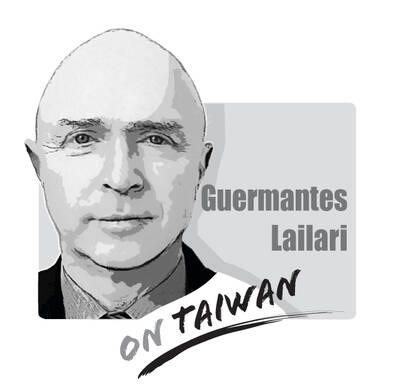Chinese Nationalist Party (KMT) Central Policy Committee director Alex Tsai’s (蔡正元) praise of Chiang Kai-shek as the “paramount warrior safeguarding Taiwan” is an attempt to boost party identity as the KMT teeters on the edge of a cliff, in defiance of historical facts.
Wednesday was the 42nd anniversary of Chiang Kai-shek’s death and Tsai used the day to plug “Chiang as a paramount warrior,” just as he did in February on the 70th anniversary of the 228 Massacre when he denied that Chiang Kai-shek was the “murderer responsible for the 228 Incident,” as many people believe.
To back up his defense of Chiang Kai-shek regarding the massacre, Tsai cited a telegram from Chiang Kai-shek asking then-Taiwan governor and commander of the Taiwan Garrison Command Chen Yi (陳儀) to “strictly prohibit military and political officials from taking revenge.”
In 2006, then-KMT lawmaker John Chiang (蔣孝嚴), Chiang Kai-shek’s grandson, cited that telegram when he sued three academics who worked on a report that labeled Chiang Kai-shek the “culprit” behind the 228 Massacre. The case was later closed without prosecution.
Academia Sinica associate research fellow Chen Yi-shen (陳儀深) later said that the telegram had been a response to reports Chiang Kai-shek received about rampant arbitrary arrests.
The telegram did not seem to have been followed by those on the ground in Taiwan as “revenge” certainly continued with the “appeasement and clearing-up” that began in late March 1947 to ferret out “bad people.”
Chen Yi, despite calls for his immediate removal from office, kept his job for a few more months until Wei Dao-ming (魏道明) was appointed the first Taiwan provincial governor, to signal a change from military-oriented to bureaucracy-based rule, in May 1947.
Chen remained a prominent KMT figure, becoming chairman of China’s Zhejiang Province, until he reportedly tried to negotiate with the CCP in January 1949. Chiang Kai-shek had him arrested for treason and he was returned to Taiwan, where he was executed in June 1950.
Former president Ma Ying-jeou (馬英九) is more honest in saying that Chiang Kai-shek was undoubtedly liable for the massacre.
As academic Huang Cheng-yi (黃丞儀) said, Chiang Kai-shek’s personal and legal responsibility could be debated, but it is hard to question his political accountability considering his supreme position as the chairman of the KMT.
In another absurd claim, Tsai said that Chiang Kai-shek “gave up the dream of launching a ‘mainland counteroffensive’ after the second Taiwan Strait crisis in 1958 in order to safeguard Taiwan.”
Tsai said Chiang Kai-shek issued a joint communique with the US publicly renouncing the use of force “to return to the mainland.”
However, historian Lin Hsiao-ting (林孝庭) found documents showing that Chiang Kai-shek had come within a hair’s breadth of launching an attack against China in 1962, but the plan was smothered by Washington.
It is preposterous for anyone to claim that Chiang Kai-shek or the KMT had abandoned the idea of a counteroffensive as early as 1958 when it was not until 1991, when then-president Lee Teng-hui (李登輝) ended the Temporary Provisions Effective During the Period of Communist Rebellion (動員戡亂時期臨時條款) decree, thereby ending 43 years of emergency rule.
It might be argued that in its latter days, the KMT authoritarian regime came to realize that it was unrealistic to have a “counteroffensive,” but it nevertheless continued to use the banner for its political interests, which included both US aid and its iron-clad grip on political power.

Chinese state-owned companies COSCO Shipping Corporation and China Merchants have a 30 percent stake in Kaohsiung Port’s Kao Ming Container Terminal (Terminal No. 6) and COSCO leases Berths 65 and 66. It is extremely dangerous to allow Chinese companies or state-owned companies to operate critical infrastructure. Deterrence theorists are familiar with the concepts of deterrence “by punishment” and “by denial.” Deterrence by punishment threatens an aggressor with prohibitive costs (like retaliation or sanctions) that outweigh the benefits of their action, while deterrence by denial aims to make an attack so difficult that it becomes pointless. Elbridge Colby, currently serving as the Under
The Ministry of the Interior on Thursday last week said it ordered Internet service providers to block access to Chinese social media platform Xiaohongshu (小紅書, also known as RedNote in English) for a year, citing security risks and more than 1,700 alleged fraud cases on the platform since last year. The order took effect immediately, abruptly affecting more than 3 million users in Taiwan, and sparked discussions among politicians, online influencers and the public. The platform is often described as China’s version of Instagram or Pinterest, combining visual social media with e-commerce, and its users are predominantly young urban women,
Most Hong Kongers ignored the elections for its Legislative Council (LegCo) in 2021 and did so once again on Sunday. Unlike in 2021, moderate democrats who pledged their allegiance to Beijing were absent from the ballots this year. The electoral system overhaul is apparent revenge by Beijing for the democracy movement. On Sunday, the Hong Kong “patriots-only” election of the LegCo had a record-low turnout in the five geographical constituencies, with only 1.3 million people casting their ballots on the only seats that most Hong Kongers are eligible to vote for. Blank and invalid votes were up 50 percent from the previous
Alarm bells over a “hollowing out” of Taiwan’s semiconductor industry and US demands for “protection money” have fueled a panic over Taiwan. To understand how misplaced these fears are, consider the movements of global technology giants. Nvidia Corp CEO Jensen Huang (黃仁勳), Advanced Micro Devices Inc (AMD) CEO Lisa Su (蘇姿丰) and Taiwan Semiconductor Manufacturing Co (TSMC) chairman C.C. Wei (魏哲家) could undoubtedly understand the situation best, and they continue to make key investments in Taiwan. They do not make decisions on a whim. They are the architects of global computing power strategy and possess the highest levels of industry knowledge. No